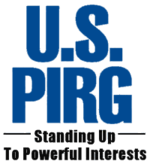Organization:Public Interest Research Group
 | |
| Motto | Standing up to powerful interests |
|---|---|
| Formation | 1971 |
| Founder | Ralph Nader[1] |
| Type | Advocacy organization |
| Location | |
| Website | uspirg |
Public Interest Research Groups (PIRGs) are a federation of U.S. and Canadian[2] non-profit organizations that employ grassroots organizing and direct advocacy with the goal of effecting liberal political change.[3]
History
The PIRGs emerged in the early 1970s on U.S. college campuses. The PIRG model was proposed in the book Action for a Change by Ralph Nader and Donald Ross. Ross helped students across the country set up the first PIRG chapters, then became the director of the New York Public Interest Research Group in 1973.[4][5]
The Minnesota Public Interest Research Group, founded in 1971, was the first state PIRG to incorporate.[6] It was followed by Oregon (OSPIRG) and Massachusetts (MASSPIRG). The PIRGs were supportive of container deposit legislation in the United States, popularly called "bottle bills".[7]
In 1982, the PIRGs established the Fund for the Public Interest as its fundraising and canvassing arm.[5]
Funding model
PIRGs on college campuses have historically been funded with a portion of student activity fees in the form of a labor checkoff. Students may elect to have the fees refunded to them, although many students are unaware that this is the case. This system of PIRG funding has been met with controversy and with a number of legal challenges.[5] In 2014, students at Macalester College in Minnesota voted to end their relationship with MPIRG due to the group's revenue structure, which relied on MPIRG automatically receiving a cut of student activity fees.[6]
Policy positions
U.S. PIRG lobbied for the creation of the Consumer Financial Protection Bureau, an independent U.S. government agency which was founded as a result of the Dodd–Frank Wall Street Reform and Consumer Protection Act in the wake of the late-2000s recession and the financial crisis.[8]
The PIRGs have worked to make same-sex marriage legal, to increase the minimum wage, to enact increased environmental regulations, to oppose Voter ID laws in the United States, build high speed rail in California, defend solar net metering in California, increase food labeling, expand open educational resources on campus, expand campus food pantries, and ban pesticides linked to colony collapse.[6]
Transparency rating
Charity Navigator rated the U.S. PIRG two out of four stars for accountability and transparency, and three out of four stars for financials.[9]
Affiliated non-profits
Some PIRGs are members of a larger network of non-profit organizations called the Public Interest Network.[10] In the past, they have also helped to launch a number of other independent public interest non-profits, including:
State affiliates
State PIRGs include:
- Arizona PIRG
- CalPIRG (California)
- Colorado Public Interest Research Group
- Connecticut Public Interest Research Group
- Florida PIRG
- Georgia PIRG
- Illinois PIRG
- Iowa PIRG
- Maryland Public Interest Research Group
- Massachusetts Public Interest Research Group
- PIRGIM (Michigan)
- Minnesota Public Interest Research Group
- MoPIRG (Missouri)
- Montana PIRG
- New Hampshire PIRG
- New Jersey Public Interest Research Group
- NCPIRG (North Carolina)
- Ohio PIRG
- Oregon PIRG
- Rhode Island PIRG
- Penn PIRG
- TexPIRG (Texas)
- WashPIRG
- WisPIRG
See also
- Environment America
References
- ↑ Rosiak, Luke (July 15, 2009). "The Liberal Sweatshop". The Daily Beast. http://www.thedailybeast.com/articles/2009/07/15/the-liberal-sweatshop.html. Retrieved 10 November 2015.
- ↑ "OPIRG: Welcome to the Provincial Network". http://www.opirg.org/.
- ↑ Ali, Ambreen (September 15, 2011). "Liberal, Conservative Groups Join to Find Spending Cuts". Roll Call. http://www.rollcall.com/news/liberal_conservative_groups_join_to_find_spending_cuts-208761-1.html. Retrieved 10 November 2015.
- ↑ Nader, Ralph; Donald Ross (1972). Action for a Change: A Student's Manual for Public Interest Organizing. New York: Grossman Publishers. ISBN 0-670-10319-5.
- ↑ 5.0 5.1 5.2 Mayer, Robert N. (2015). Watchdogs and Whistleblowers: A Reference Guide to Consumer Activism. ABC-CLIO. p. 389. ISBN 9781440830006.
- ↑ 6.0 6.1 6.2 Verges, Josh (November 19, 2014). "Macalester College students reject MPIRG on campus". Pioneer Press. http://www.twincities.com/education/ci_26969904/macalester-students-reject-mpirg-campus. Retrieved 10 November 2015.
- ↑ Lanier Hickman, H. (2003). American Alchemy: The History of Solid Waste Management in the United States. ForesterPress. p. 386. ISBN 9780970768728.
- ↑ "The Hill: Top 10 Lobbying Victories of 2010". http://thehill.com/business-a-lobbying/133691-the-top-10-lobbying-victories-of-2010. Retrieved October 8, 2012.
- ↑ "Charity Navigator Rating - U.S. PIRG Education Fund". http://www.charitynavigator.org/index.cfm?bay=search.summary&orgid=5433#.Vj1SPrerS70.
- ↑ "Public Interest Network". 2012. http://www.publicinterestnetwork.org/. Retrieved October 9, 2012.
- ↑ 11.0 11.1 Brobeck, Stephen (1998) (in English). Encyclopedia of the consumer movement. ABC-Clio. ISBN 0874369878. http://www.worldcat.org/oclc/863416867.
External links

